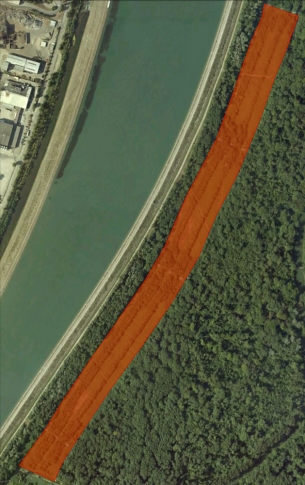News
2012-10-28
Strasbourg : structurally rich forest edges
On mid of October, the team of the project ELIA LIFE/RTE took the opportunity of a trip to France to visit the nature reserve “Ile du Rohschollen” in Strasbourg
On mid of October, the team of the project ELIA LIFE/RTE took the opportunity of a trip to France to visit the nature reserve "Ile du Rohschollen" in Strasbourg (http://www.rn-rohrschollen.strasbourg.eu/). This reserve of about 300 ha consists of alluvial grasslands and forests and is crossed by several parallel high-voltage lines. The site is managed by the City of Strasbourg which, under and in close proximity to the power lines, has gradually developed a differentiated management with the confidence of RTE.
Until some fifteen years ago, the wide safety corridor (approximately 100 m) of these lines was, like many others, mulched every 2-3 years. This radical technique which involves grinding the entire vegetation and sometimes in depth, can sometimes be harmful to the biodiversity, especially if the operation is repeated regularly and on sensitive natural habitats.

Corridor of 100 m large completely mulched until 15 years ago
Starting from an empty situation left after a complete clear-cut of the vegetation, the site managers and RTE challenged themselves to make it more favorable to biodiversity with reducing interventions on vegetation and continuing to ensure safe transport of electricity. The area under overhead lines is since then submitted to an annual late mowing. To limit soil enrichment and thus the development of a banal nitrophilous flora, the product of mowing is exported and valorized in a nearby composting facility. In the first instance, on both sides of the outer lines and between these three mowed bands, a woody spontaneous vegetation developed freely. Over the years, bushes of 2nd and 3rd height were then deliberately favored over the trees of the first height, which can represent a hazard to the lines in case of falling or any sort of contact.

Grass areas between the edges restaured during the last fifteen years
After a bit dubious start, the designation of major trees to be felled has now become an annual routine for the self-taught forester team of the City of Strasbourg. Similarly, the identification and the falling out, within the inner edges, of stems that could potentially one day be a problem for the security lines are performed each year.
The maintenance of this forest edge is therefore incumbent upon the City of Strasbourg which, on the one hand, contributes to the development of the Green Network and promotes the biodiversity and, on the other hand, receives a financial return through the periodical exploitation of large timber located in the outer edge of the safety corridor.
In order to obtain a harmonious landscape and to break the straightness of corridors, shrubs growing at the foot of the towers, where the cables reach their maximum height, were left. Foots of towers are partially hidden but remain fully accessible to technical teams of RTE. This strategy gives a characteristic shape of rugby balls to herbaceous clearings. This non-rectilinear shape edges significantly increases their landscape value.
Within herbaceous areas, managers have been confronted with a rapid unbridled colonization of Goldenrod (Solidago sp.), an invasive herbaceous species native to America. This plant has an unfortunate tendency to form large clumps of and, through its dense coverage, to considerably limit the development of native flora. After several unsuccessful attempts, however, managers are able to eradicate it in many places by mowing during the four first years in early summer (before flowering) and a second cut when the plant has done new shoots. The mowed parts were then exported. This double annual mowing finally exhaust the plant by depleting the reserves accumulated in the root system.

After 15 years of management, the site is now made up of alternating mowed grassy areas and shrubs that are no longer any danger to power lines. Such a mosaic of habitats is favorable to many species, including butterflies or birds, including for example the Red-backed Shrike who found there a biotope that meet its requirements.
According to managers, these edges are now stabilized: the time to spend on the designation of the felling of dangerous trees is much lower than before. On this site, the work of RTE in terms of safety of the lines is limited to a helicopter hovering and, in case of doubt, a visual inspection on the spot. The resulting potential felling then being assigned, after dialogue with the Forest Service, to the City of Strasbourg, as the site manager.
The layered edges of the "Ile du Rohschollen" are therefore further evidence that it is possible to combine human activity, moreover industrial with the revitalization of biodiversity.




